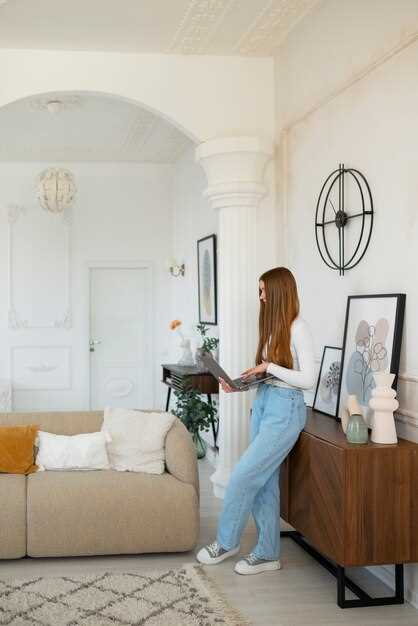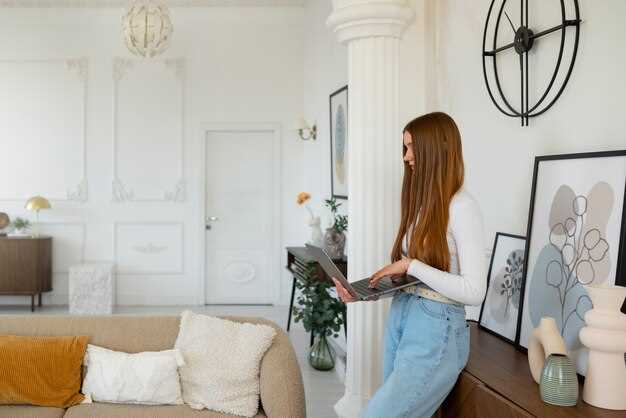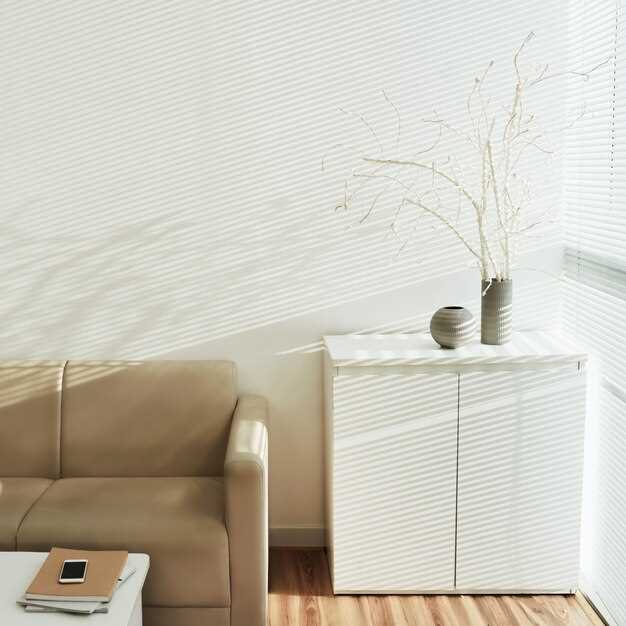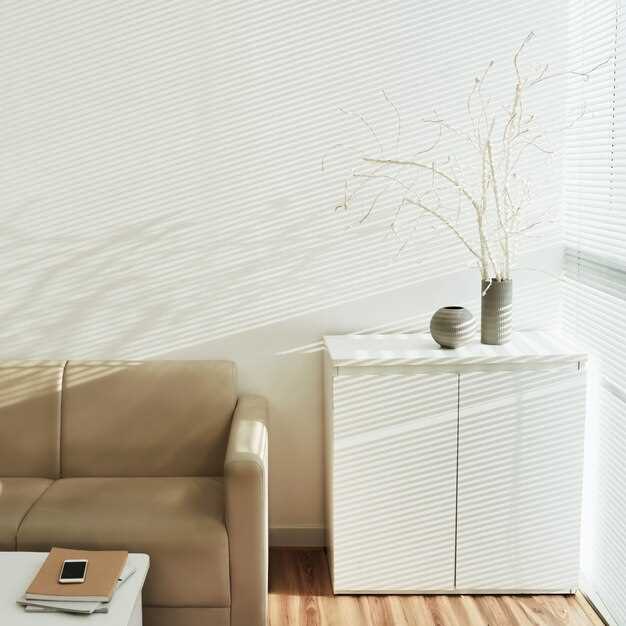Focus on functional furniture that doubles as storage to enhance your space. Choose a bed with drawers underneath or a coffee table with hidden compartments. This reduces clutter while keeping your belongings easily accessible.
Light colors and mirrors play a pivotal role in creating an open atmosphere. Opt for a light color palette on walls and furniture. Incorporate mirrors strategically to reflect light and make your apartment feel larger than it is.
Invest in multifunctional decor. A stylish ottoman can serve as extra seating, storage, or a coffee table. By selecting pieces that serve multiple purposes, you maintain style without sacrificing space.
Implement organization systems that fit your lifestyle. Use vertical storage solutions like shelving units or wall-mounted racks to maximize floor space. Keep frequently used items within easy reach, while infrequently used items can be stored higher up.
Prioritize a minimalistic mindset by decluttering regularly. Keep only items that you use or cherish. A well-edited collection of belongings not only simplifies your space but also enhances your overall aesthetic.
Selecting the Right Furniture for Small Spaces

Choose multifunctional furniture to maximize utility. Consider a sofa bed or a storage ottoman that provides seating and keeps items organized. A foldable dining table can adapt to your needs while saving space when not in use.
Opt for furniture with a lightweight design. Airy pieces, such as clear acrylic chairs or refined metal tables, create an illusion of spaciousness. Avoid bulky or heavy items that dominate the room.
Incorporate vertical storage solutions. Use tall bookshelves or wall-mounted shelves to draw the eye upward, freeing up floor space and creating storage without cluttering. Utilize under-bed storage to keep items out of sight while remaining accessible.
Invest in modular furniture that can be rearranged as necessary. Modular sofas can be reconfigured for gatherings or everyday comfort, adapting to different situations without the need for large, fixed pieces.
Pay attention to scale. Select smaller proportions to maintain harmony within the space. For instance, scale coffee tables and side tables down to avoid overwhelming visual weight.
| Furniture Type | Features | Benefits |
|---|---|---|
| Sofa Bed | Convertible | Seating and sleeping options |
| Storage Ottoman | Hidden storage | Seating and organization |
| Foldable Dining Table | Compact and expandable | Flexible dining space |
| Wall-Mounted Shelves | Vertical storage | Maximizes floor space |
| Modular Sofa | Versatile configuration | Adaptable to various needs |
Select light colors or reflective finishes to enhance your small space visually. Light-toned furniture can brighten areas, while mirrors can create a sense of depth. This strategy can trick the eye into perceiving a larger area.
Focus on quality over quantity. A few well-chosen pieces add character and style without overwhelming the room. Prioritize functional items that meet both aesthetic and practical needs.
Creative Storage Solutions for a Minimalist Closet

Use vertical space for storage by installing shelves above hanging rods. This setup keeps frequently used items at eye level while maximizing the area for less-used items up high. Add baskets or bins on the shelves to hold seasonal clothing, accessories, or shoes, giving you a tidy appearance.
Multi-functional Hangers
Incorporate multi-functional hangers that allow you to hang multiple items vertically. For instance, cascading hangers can hold several shirts or pants in a single space, reducing clutter and keeping everything organized. This method not only saves space but also makes choosing outfits easier.
Drawer Dividers
Implement drawer dividers to keep accessories, socks, and undergarments organized. This simple addition enhances visibility, ensuring items are easy to find. Consider using adjustable dividers that fit your specific drawer sizes, allowing you to customize the layout based on your needs.
Designing a Multifunctional Living Room

Choose furniture that serves multiple purposes. A sofa bed transforms your living room into a guest bedroom, while an ottoman with storage can double as a coffee table.
Maximize Vertical Space
Utilize wall-mounted shelves to display decor and essentials, freeing up floor space. Tall bookshelves draw the eye upward, creating an illusion of a larger room.
Incorporate Modular Furniture
- Consider modular sofas that can be rearranged to suit various needs.
- Use nesting tables that can be expanded for entertaining or stored away when not in use.
- Opt for a foldable dining table that can accommodate guests during gatherings and be collapsed afterward.
Create defined areas within the living room using area rugs. This delineation visually separates spaces for relaxation, work, or play.
Choose a cohesive color palette. Light colors and complementary shades make the room feel open while adding a touch of style. Accents in brighter colors can act as focal points without overwhelming the space.
Incorporate lighting strategically. Use layered lighting, such as floor lamps and table lamps, to enhance functionality and ambiance. Adjustable fixtures allow you to modify the mood based on activity.
- Install dimmer switches for flexibility in lighting options.
- Place task lighting in work areas to improve visibility.
Finally, add personal touches with decor that reflects your style. Choose versatile pieces that can be easily swapped out without requiring major changes to your setup.
Choosing a Color Palette to Enhance Space

Select a light, neutral color palette to create an airy feel. Shades like soft white, cream, or pale gray reflect natural light, making small areas appear larger. Combine these with occasional pops of color through accessories, artwork, or plants for a striking contrast.
Accent Colors and Their Impact
Add accent colors strategically to draw attention to specific areas. For instance, a rich navy or deep green works well for a single wall, providing depth that enhances the overall aesthetic. Balance darker tones with lighter ones to maintain an open atmosphere.
Creating Cohesion
Establish a harmonious flow by keeping colors consistent throughout spaces. Transition from living areas to kitchens and bedrooms using similar tones. This unification minimizes visual distractions, giving an impression of expansive continuity.
Experiment with texture and materials alongside your chosen palette. Matte finishes, glossy tiles, or natural wood can bring your colors to life while maintaining simplicity. A well-curated color palette not only enhances space but also reflects your unique style.
Incorporating Natural Light in Your Apartment
Maximize natural light by using sheer curtains instead of heavy drapes. This allows sunlight to filter through while providing privacy. Choose light-colored fabrics that enhance brightness and reflect light around the room.
Mirrors serve as a practical solution for amplifying natural light. Place a large mirror opposite windows to reflect light and create an illusion of depth. Small mirrors can also be strategically placed to catch and bounce light throughout your space.
Opt for light-colored paint on walls and ceilings. Whites, creams, and soft pastels amplify brightness, making your apartment feel airy and spacious. A glossy finish on walls can further enhance light reflection.
Maintain an uncluttered environment. Ensure that furniture placement does not obstruct window areas. Select multifunctional furniture that can be easily moved or reconfigured to allow more light to travel through the space.
Consider glass furniture or elements like a glass coffee table, which allows light to pass through, preventing visual obstruction. Glass shelving can also add style while maintaining an open feel.
Utilize artificial lighting strategically to complement natural light. Use warm LED bulbs in fixtures that provide a warm glow, effectively blending with the natural ambiance during evening hours.
Incorporate plants to brighten corners and enhance your space’s liveliness. Choose plants that thrive in indirect sunlight and complement your interiors without taking up excessive space.
Finally, select window treatments that can be easily adjusted. Roman shades or roller blinds allow you to control the amount of light coming in while being decorative and minimalist.
Decluttering Strategies for a Minimalist Home
Use the “one in, one out” rule. For every new item you bring into your home, remove an existing one. This maintains balance and prevents accumulation.
Set a timer for 15 minutes daily. Focus on a small area, like a drawer or a shelf. This turns decluttering into a manageable, consistent habit.
Organizational Methods
- Use clear bins: Store items in transparent containers. This makes it easy to identify contents without opening each container.
- Label everything: Clearly label storage areas to simplify retrieval and encourage returning items to their designated spots.
- Maximize vertical space: Install shelves to utilize walls. This keeps the floor area open, making rooms feel larger.
Prioritizing Essentials
- Conduct a wardrobe audit. Keep versatile pieces that you love and wear regularly. Donate anything you haven’t worn in the past year.
- Evaluate kitchen items. Keep only utensils or gadgets that serve a purpose in your cooking routine. Eliminate duplicates.
- Limit decorative items. Choose a few meaningful pieces that complement your style, and store or donate the rest.
Regularly assess your belongings. Every few months, revisit your items and determine if they still hold value in your life. This keeps your space fresh and functional.
Decluttering isn’t a one-time task. Integrate these strategies into your routine for a consistently minimalist environment.
Essential Decor for a Stylish Minimalist Look
Choose a limited color palette to create harmony in your space. Stick to soft neutrals like white, beige, and gray, accented with one or two bolder colors for interest. This approach maintains a clean aesthetic while allowing for personal expression.
Functional Furniture
Select multifunctional furniture pieces that serve more than one purpose. A sleek coffee table with storage can hold books or magazines while keeping clutter at bay. Consider a sofa bed for hosting guests without compromising on space.
Artwork and Accents
Incorporate a single statement piece of art to anchor your room. A large canvas or an oversized photograph can become a focal point without overwhelming the decor. Complement it with a few minimalist accessories, such as geometric vases or simple sculptures, to add character.
Utilize natural materials like wood or stone in decor items. A wooden bowl or a stone planter offers warmth and texture, enhancing the minimalist theme. Keep surfaces clear to emphasize these decor choices and avoid visual clutter.
Lighting plays a key role in minimalism. Opt for streamlined fixtures like pendant lights or wall sconces that blend with your style. Soft, ambient lighting creates a cozy atmosphere while contributing to a modern look.
Incorporate greenery to introduce life into your space. Select low-maintenance plants, such as succulents or snake plants, and display them in simple pots. This element of nature adds vibrancy while keeping the overall design understated.
Mainaining a Balanced Minimalist Lifestyle
Organize your belongings into categories: keep, donate, and discard. Regularly assess each item based on its utility and emotional value. If it hasn’t been used in the past year and doesn’t bring happiness, consider letting it go. This practice refreshes your space and promotes clarity in thought.
Create Multifunctional Spaces
Utilize furniture that serves multiple purposes. A sofa bed can transform a living area into a guest room, while storage ottomans provide both seating and space for items. This functionality saves space and enhances the usability of your apartment.
Incorporate Natural Elements
Add plants for a touch of nature and improved air quality. Choose low-maintenance varieties like snake plants or succulents for ease of care. Incorporating natural materials in your decor, such as wooden furniture or woven baskets, brings warmth and balance to minimalist design.
Video:
Maximizing Space in a Small Apartment: Top Design Hacks for a Spacious Feel
Maximizing Space in a Small Apartment: Top Design Hacks for a Spacious Feel by CosySpace Living 7,562 views 5 months ago 24 minutes
Q&A:
What are the benefits of minimalist apartment living?
Minimalist apartment living offers a range of benefits, including reduced clutter, easier maintenance, and a more serene environment. By focusing on essential items, residents can cultivate a space that promotes relaxation and mindfulness. This lifestyle often encourages individuals to prioritize quality over quantity, leading to more meaningful possessions and experiences. Additionally, minimalism can save money and time, allowing more resources to be allocated towards personal interests and experiences rather than material goods.
How can I maximize space in a small apartment?
Maximizing space in a small apartment can be achieved through several strategies. First, consider using multifunctional furniture, like a sofa that converts into a bed or a coffee table with storage. Vertical space is also your friend; wall-mounted shelves and tall bookcases can draw the eyes upward and create more storage without taking up precious floor space. Additionally, keeping decor minimal and using light colors can create an illusion of a larger area. Finally, organizing and decluttering regularly will help maintain an open and spacious feel in your home.
What style elements should I consider for a minimalist apartment?
When designing a minimalist apartment, focus on simplicity and functionality. Clean lines and neutral color palettes can create a calm and stylish atmosphere. Incorporating natural materials, such as wood or stone, can add warmth while maintaining a minimalist aesthetic. Accessories are kept to a minimum but should be meaningful; choose statement pieces that reflect your personality. Finally, ensure that lighting is soft and inviting, as it plays a crucial role in enhancing the overall ambiance of the space.
Are there any tips for maintaining a minimalist lifestyle over time?
Maintaining a minimalist lifestyle requires ongoing effort and mindfulness. Regularly assess your belongings, ensuring that each item serves a purpose or brings you joy. Setting specific times, such as at the change of seasons, to declutter can help keep your space organized. It’s also helpful to establish a one-in, one-out rule, meaning that for every new item you bring into your home, an old one should go. Staying mindful of your purchases and prioritizing needs over wants can help you stick to a minimalist principle long-term.


